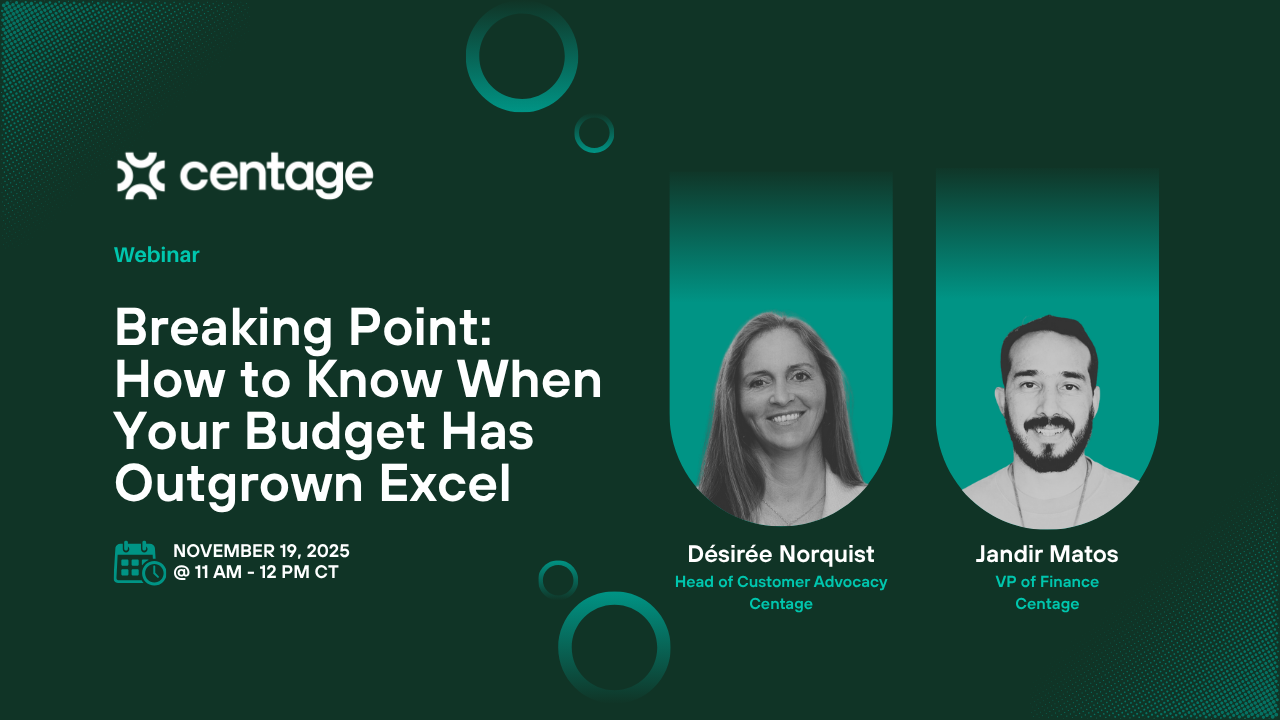Level Up Your Budgeting: Smarter Financial Forecasting for CFOs
Post Overview:
- Strategies to turn chaotic and fragmented budgeting into a streamlined and collaborative process.
- Techniques for enhancing data security during the financial forecasting stages.
- Best practices for engaging and integrating technology to facilitate real-time, year-round planning.
Level Up Your Budgeting: Smarter Financial Forecasting for CFOs
Budgeting is more than just setting financial targets; it’s like creating the ultimate strategy guide for your organization’s financial success. Just like in a game where you need a solid plan to level up, a well-structured budget helps lay out your expected revenues, allocates resources wisely, and sets spending limits, acting as your playbook to guide decisions throughout the year.
Now as a CFO, during the strategizing stage, you’ve likely encountered the daunting challenges of consolidating fragmented financial data, and the annual budgeting process might feel like a never-ending grind. It’s no surprise that many CFOs are on the hunt for better solutions to streamline these processes.
And here’s the thing: those challenges you face are also opportunities to drive your organization forward. By transforming these obstacles into growth and efficiency boosters, you can ensure that your financial planning not only meets, but surpasses the strategic demands of your company. Ready to level up your financial game? Dive in and explore how collaborative tools can turn these challenges into winning strategies.
Embracing Collaboration to Enhance Strategic Adaptability
Traditional budgeting often falls into the trap of a top-down approach, where directives are handed down without much input from various departments, like playing a game where you’re only given a set of rules without understanding the levels or challenges. This lack of engagement can lead to unrealistic budgets that don't reflect the true needs or capabilities of each department. Without the involvement of those who know the day-to-day operations best, the budget risks becoming a disconnected set of targets rather than a practical roadmap.
To shift away from this approach, imagine a budgeting model that fosters collaboration from the ground up. By involving all departments in the budgeting process, you create a system where diverse perspectives are not only welcomed but essential. This model promotes better accountability, as departments have a hand in shaping the budget and are more committed to meeting their targets. Enhanced communication across teams ensures that everyone is aligned and working towards common goals, leading to quicker problem-solving and more agile decision-making.
It doesn’t end there. Encouraging regular input through a shared platform where data can be entered directly into the system minimizes errors and keeps everyone’s voice heard. This collaborative approach doesn't just streamline the process, it also improves accuracy and boosts overall morale, especially when employees see their contributions valued and incorporated into the budget, their engagement and cooperation increase.
Get a Boost Up with Cross-Departmental Collaboration for a Stress-Free Budgeting Process
Crafting a budget shouldn’t feel like grinding through tedious levels. Instead, build smart budgeting templates that take on the repetitive tasks for you.
- Use rock-solid templates that automatically pull data from previous years, which allows budget owners to seamlessly add their input to specific areas.
- Start budget walkthroughs with budget owners early in the game to avoid that last-minute scramble and ensure everyone stays accountable.
- Standardize your templates, reports, and budgets to make it easy for everyone to contribute their part.
Aligning departmental goals with the company’s overarching strategy is like making sure your team is working towards the same objective. If the goal is to boost sales by a specific percentage and in a specific region, then ensure any department head that is involved are all questing after the same prize. This approach not only brings everyone onto the same page but turns the budget into a strategic roadmap rather than just another document.
Pro tip: consider linking compensation to goal alignment to increase buy-in and goal agreement.
Finally, break down strategic goals into micro-goals, especially for newer team members, so that accountability is part of everyone’s journey from the start. By leveraging technology for real-time insights, you can keep everyone aligned with each small step and ensure that progress towards these goals is visible and actionable at every level.
Leveraging Technology for Real-Time Data Security and Integration
One of the primary concerns for any CFO is ensuring data security, especially when that data affects every component of the organization. Traditional methods of sharing files such as emailing or saving copies of files to send, can lead to significant security risks and data integrity issues. For instance, imagine a scenario where a critical financial report is emailed between departments, and a version is accidentally sent to an unauthorized person. This not only compromises the confidentiality of sensitive information but also risks the integrity of the data if incorrect versions are used for decision-making.
Building on the foundation of collaboration, by utilizing integrated financial planning software, CFOs can maintain robust data security protocols while providing authorized access to necessary parties. This approach ensures that only those with the proper credentials can view or edit specific data, reducing the risk of unauthorized access. Solutions that offer these real-time updates and role-specific access can transform a once hefty process into a secure, streamlined workflow.
Moreover, these technologies come with advanced integration capabilities, allowing CFOs to pull data from various sources into a single, secure platform. This not only reduces the risk of errors but also saves considerable time and resources previously spent on manual data consolidation.
Transforming Budgeting from Annual to Continuous
As businesses evolve, so does the approach to managing their finances. With the rise of integrated financial planning software, budgeting is no longer just an annual checkbox exercise, disconnected from the dynamic nature of business. It's becoming a continuous, dynamic process that adapts in real time to changing conditions, and by shifting to continuous planning models supported by the right technology, budgeting can become a dynamic tool that offers real-time insights and fosters proactive decision-making, keeping you in the game.
Continuous planning allows for regular adjustments based on operational realities, market conditions, and emerging opportunities, all of which can constantly change. It provides a strategic advantage, enabling CFOs to be more responsive and adaptive, which means instead of working with a static budget that feels out of sync with the current landscape, you’re equipped with a flexible, evolving plan that actively guides your decisions. In this way, you’re not just managing resources but actively leading your organization toward success.
Best Practices for Streamlined Financial Forecasting
When it comes to financial forecasting, efficiency is a key part to staying ahead in today’s fast-paced business environment. Just like in a game, where having the right strategy can make all the difference, implementing best practices in your forecasting process can set you up for success. Here are five essential tips to help you streamline your financial forecasting and keep your organization on the winning path.
1. Implement collaborative platforms: Choose tools that enhance collaboration across departments, allowing for real-time input and revision, which encourages ownership and alignment on financial goals.
2. Automate data consolidation: Reduce the risk of human error and the labor-intensive process of merging data by automating these processes with integrated financial planning tools.
3. Shift to continuous planning: Move away from annual budgeting cycles and adopt a continuous planning process to make your financial strategies more adaptable and aligned with ongoing business changes.
4. Prioritize security: Ensure that any financial planning tool you adopt comes with top-notch security features to protect sensitive data and comply with industry regulations.
5. Invest in training: To overcome resistance and integration complexities, invest in comprehensive training for your staff to ensure they are comfortable and proficient with new tools and processes.
Still Have Questions?
- How can CFOs ensure data security when integrating new financial planning tools?
Ensure that any new tool complies with global security standards, offers encrypted data storage and transfer, and allows for role-based access controls.
- What are the first steps toward moving from an annual to a continuous planning process?
Start small by integrating quarterly reviews and forecasts into your processes, using these smaller cycles to adjust plans as needed before fully transitioning to continuous planning.
- Can financial planning tools be integrated with existing systems?
Most modern tools are designed with integration in mind, capable of synchronizing with existing ERP, HRM, and CRM systems to provide a cohesive and streamlined experience.
Streamlining and mastering your financial planning processes doesn't have to be a daunting task. By embracing collaborative, technology-driven strategies, you can transform your budgeting headaches into a dynamic framework that drives business success, making your role as a CFO not just about managing finances but empowering your organization to thrive in an ever-changing business landscape.
To see firsthand how Centage can transform your financial operations and variance analysis, book a demo today and take the first step toward optimizing your financial performance and strategic decision-making.
Keep reading...
Interviews, tips, guides, industry best practices, and news.


